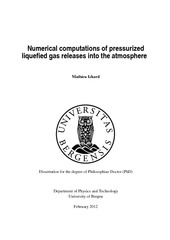| dc.contributor.author | Ichard, Mathieu | eng |
| dc.date.accessioned | 2013-06-21T08:14:46Z | |
| dc.date.available | 2013-06-21T08:14:46Z | |
| dc.date.issued | 2012-04-13 | eng |
| dc.identifier.isbn | 978-82-308-2010-0 | en_US |
| dc.identifier.uri | https://hdl.handle.net/1956/6711 | |
| dc.description.abstract | There is great concern about accidental releases and dispersion of toxic and flammable industrial chemicals into the atmosphere. Their toxic effects and/or flammable properties, combined with their widespread use and transport through urban areas, make most industrial chemicals very dangerous. Many industrial chemicals are transported and stored as pressurized liquefied gases in large quantities. The chemical, petrochemical and petroleum industries, as well as regulatory agencies, need realistic dispersion simulations for risk analysis purposes. If accidentally released into the atmosphere, a pressurized liquefied gas suffers a rapid de-pressurisation and as a consequence boils violently. This process is referred to as the flashing process. Complete flashing results in the formation of a two-phase jet with high momentum. Some of the droplets may deposit on the ground and form a pool which gradually evaporates. This thesis presents the development of a Computational Fluid Dynamics (CFD) methodology for studies of pressurized liquefied gas releases into the atmosphere. The methodology is implemented in the CFD model FLACS. The performances of existing source term models in predicting recent experimental observations are assessed. It is found that the energy balance model gives the best predictions for the mass flow rate at the exit orifice. Uncertainties are present in the quality of the predictions for the size distribution of droplets and it is recommended to perform sensitivity studies. Investigation of the dispersion of heavy particles in isotropic turbulent flows by means of the Kinematic Simulation approach allows emphasizing the importance of the inertia and crossing trajectory effects. An Euler-Euler approach based on the assumption of homogeneous flow, namely the Homogeneous Equilibrium Model (HEM), and an Euler-Lagrange approach are implemented in the FLACS CFD model in order to simulate two-phase flows. The two-phase flow models are validated against laboratory scale experiments. Improvements of the current FLACS models for liquid spreading and evaporation on the ground are developed and an algorithm is implemented in order to solve the equations of the pool model on a user-defined uniform grid. Obstructed and non-obstructed large-scale experiments are simulated with the new methodology. The validation of the methodology with both the HEM and the Euler- Lagrange approaches is shown to be relatively successful. Its simplicity of use makes the HEM approach very attractive for industrial applications. The Euler-Lagrange approach has a wider range of physical applications and provides more options to characterize the dispersed phase and its interaction with the continuous phase. This approach should be used when the HEM approach reaches its limitations. | en_US |
| dc.language.iso | eng | eng |
| dc.publisher | The University of Bergen | en_US |
| dc.relation.haspart | Paper I: Ichard, M. & Melheim, J. (2010) Dispersion of heavy particles in turbulent-like flows. Full text not available in BORA. | en_US |
| dc.relation.haspart | Paper II: Middha, P., Ichard, M. & Arntzen, B. J. (2010) Validation of CFD modelling of LH2 spread and evaporation against large-scale spill experiments. International Journal of Hydrogen Energy 36(3): 2620–2627, February 2011. Full text not available in BORA due to publisher restrictions. The article is available at: <a href="http://dx.doi.org/10.1016/j.ijhydene.2010.03.122" target="blank"> http://dx.doi.org/10.1016/j.ijhydene.2010.03.122</a> | en_US |
| dc.title | Numerical computations of pressurized liquefied gas releases into the atmosphere | en_US |
| dc.type | Doctoral thesis | |
| dc.rights.holder | Copyright the author. All rights reserved | en_US |
